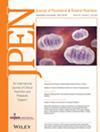Association between parenteral nutrition and length of stay in late preterm and term infants: A retrospective cohort study
Abstract
Background
We aimed to determine how the use of parenteral nutrition in late preterm and term infants admitted to the neonatal intensive care unit (NICU) affects outcomes, specifically length of stay.
Methods
This is a retrospective cohort study that included infants ≥35 weeks gestation admitted to a Pediatrix Medical Group–affiliated NICU on day of life 0–2 in 2009–2019. Propensity score matching was used to control for demographics, delivery characteristics, and severity of illness. Infants were excluded if they received comfort or palliative care in the delivery room or transferred before discharge home. The primary outcome was length of stay. Secondary outcomes were duration of conventional and high-frequency ventilation, late-onset sepsis, and mortality.
Results
The total cohort had 470,433 neonates; of the 259,495 infants who met inclusion criteria and survived to discharge, 97,577 (37.6%) received parenteral nutrition. Of 59,580 propensity-matched neonates comparing parenteral nutrition vs no parenteral nutrition, those receiving parenteral nutrition (n = 29,790) had a longer median length of stay (10 vs 9 days, P < 0.0001). Analysis of secondary outcomes revealed a higher mean number of conventional ventilation days, higher odds of late-onset sepsis, and higher odds of mortality in neonates receiving parenteral nutrition vs no parenteral nutrition.
Conclusion
Parenteral nutrition in late preterm and term neonates is associated with increased length of stay, duration of conventional ventilation, and odds of late-onset sepsis and mortality. Prospective clinical trials are needed to better understand the optimal use and timing of parenteral nutrition and associated morbidities in this population.


 求助内容:
求助内容: 应助结果提醒方式:
应助结果提醒方式:


